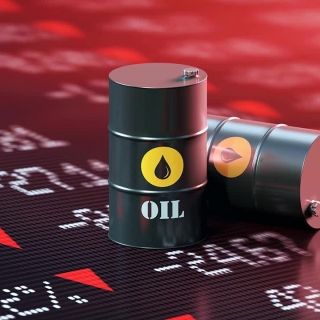


Bearish signs are emerging in the oil market after US President Donald Trump's latest tariff threats sparked fears of an imminent oversupply.
The West Texas Intermediate crude oil timeframe beginning in February 2026 and the following months has shifted into contango, a structure in which prices near that point trade at a discount to older prices.
The repricing that began late last week dashed hopes that the market could avoid a long-anticipated oversupply, just as new US tariff threats against China are hurting demand prospects for the world's two largest crude importers.
The crude oil market is being pressured by rising production both inside and outside the OPEC+ alliance, which agreed in early October to increase production quotas in an effort to regain market share. Banks including Goldman Sachs Group Inc. and Morgan Stanley recently cut their oil price forecasts for this year, and if New York-traded futures contracts continue to decline in the coming months, US drillers could come under pressure. The headline WTI futures contract edged higher on Monday after closing last week at its lowest level since May.
Bearish gloom is also evident in other corners of the market. The benchmark US contract for the entire calendar year 2026 traded below $60 on Friday, while the December-December spread, a preferred trade among oil-focused hedge funds, fell to its weakest level since June.
Sentiment in WTI second-month options is near its most bearish in four months. Some of this stems from traders betting that near-term futures contracts will weaken more than longer-dated contracts, which tends to occur during periods of oversupply. Open interest in these bets—known as calendar spread options—has surged over the past year as outright prices fluctuate within a range, flanked by geopolitical risks and rising OPEC+ supply.
This weakness poses a problem for the shale industry, which prefers oil above $60 per barrel to drill profitable new wells. The Energy Information Administration (EIA) expects overall US crude oil production to decline slightly next year as volatile prices hamper some drilling, which would be the first annual production decline since 2021.
However, many market participants see the current conditions paving the way for future supply pressures that could actually support prices going forward. "In many respects, this bodes well for oil prices in 2026," said Jon Byrne, an analyst at Strategas Securities. "We really need a boost here to curb US production in the coming calendar year, in addition to broader non-OPEC supply."
For now, the near-term portion of the futures curve remains subject to a backwardation structure that typically indicates tight supply. This is partly due to geopolitical risks—including increased drone attacks on Russian energy assets, the persistent threat of US sanctions on major producers like Iran, and strong domestic demand.
"A sustained decline in WTI towards $50 is unlikely unless a global recession scenario emerges, but on the other hand, it's difficult to imagine a catalyst that would push prices significantly higher," said Pavel Molchanov, an analyst at Raymond James. (alg)
Source: Bloomberg
World oil prices rose after US President Donald Trump said that Indian Prime Minister Narendra Modi planned to halt oil purchases from Russia. This move could tighten global supply, as India is a majo...
Oil prices fell on Wednesday to a five-month low due to escalating US-China trade tensions and the International Energy Agency's (IEA) prediction of a supply surplus in 2026. Brent crude fell 48 cent...
Oil prices plummeted on Wednesday (October 15th), holding near five-month lows for a second day, pressured by escalating US-China trade tensions and the International Energy Agency's (IEA) prediction ...
Oil prices stabilized after hitting a 5-month low. WTI hovered near $59/barrel and Brent around $62, indicating the market remains hesitant after the previous sharp decline. The IEA predicts an unpre...
Oil prices fell on Tuesday (October 14th), closing 1.5% lower as the International Energy Agency (IEA) warned of a large oversupply by 2026, and due to ongoing trade tensions between the US and China,...
The Hong Kong stock market posted moderate gains on Thursday (October 16th), with the Hang Seng Index rising 96 points, or 0.37%, to 26,007. This increase occurred despite mixed performance in the technology and financial sectors. Major tech stocks...
Australia's unemployment rate jumped to 4.5% in September, its highest level since 2021. This figure was worse than expected and indicates that the labor market is starting to weaken. Data from the Australian Bureau of Statistics also showed that...
Asian stock markets opened higher on Thursday morning (October 16th), following a positive close on Wall Street despite volatile trading. Stocks in Japan, Australia, and South Korea rose, while index futures pointed to a weaker opening in Hong...
 Asia-Pacific markets traded mixed Tuesday, breaking ranks with Wall Street that soared after U.S. President Donald Trump softened his stance on...
Asia-Pacific markets traded mixed Tuesday, breaking ranks with Wall Street that soared after U.S. President Donald Trump softened his stance on...
 European stocks started the week in positive territory, with the STOXX 50 rising 0.9% and the STOXX 600 adding 0.6%, as traders geared up for the...
European stocks started the week in positive territory, with the STOXX 50 rising 0.9% and the STOXX 600 adding 0.6%, as traders geared up for the...
 President Donald Trump arrived in the Egyptian resort of Sharm El-Sheikh on Monday for a summit with several other world leaders aimed at ensuring...
President Donald Trump arrived in the Egyptian resort of Sharm El-Sheikh on Monday for a summit with several other world leaders aimed at ensuring...
 Fed Chairman Jerome Powell hinted that the central bank may stop shrinking its balance sheet in the coming months.
The Fed chairman also indicated...
Fed Chairman Jerome Powell hinted that the central bank may stop shrinking its balance sheet in the coming months.
The Fed chairman also indicated...